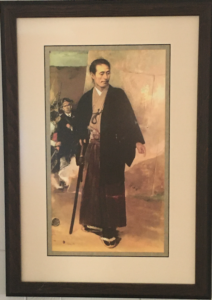
The title of this painting, “returning from the surrender of Edo Castle,” is misleading because Katsu Kaishū did not attend the official (formal) surrender ceremony. But he did negotiate the peaceful surrender of the castle with Saigō, which of course resulted in the actual surrender. For that he was considered a traitor by many in the Tokugawa camp. Behind Kaishū is supposed to be a stonewall of the castle, to the left side of which is a fellow Bakufu samurai, sword drawn, as if ready to attack him.
This portrait is based on a photograph taken at the British Legation in Yokohama by Ernest Satow, secretary to Sir Harry Parkes, the British minister to Japan, around the time the castle was surrendered. “I was so very sleepy at the time,” Kaishū recalled years later. “But they dragged me over there. Satow took it, because, as he said, ‘You’re going to be killed.’”
This painting is the work of Kawamura Kiyo’o, whose grandfather, Kawamura Tajima-no-Kami, a high official in the Bakufu, had served in magisterial posts in Niigata, Sakai, Osaka, and Nagasaki. Kiyo’o, who grew up in Nagasaki, developed a keen interest in oil painting, a Western art form. He was sent to study in the United States in 1871, after which he traveled to Europe to study oil painting in France and Italy. Kaishū built a studio for Kawamura within the compound of his estate at Hikawa in Tokyo.

